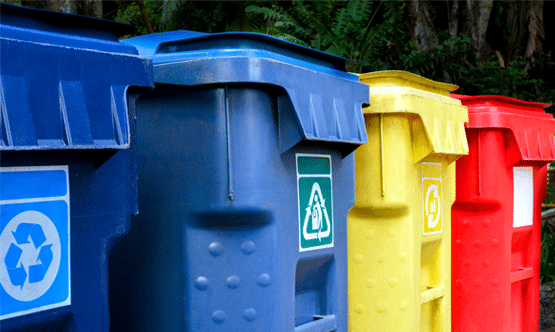1970

|
Summary : In the early 1970’s, the The first Earth Day brings awareness of the importance of recycling and the creation of the universal recycling symbol makes recyclables easy to recognize. Communities begin to recycle more. 1972: The first U.S. recycling mill is built in Conshohocken, PA. 1974: University City, MO is one of the first municipalities to offer curbside recycling. 1976: The Federal Resource Conservation and Recovery Act is passed following the increase of municipal and industrial waste throughout the United States [1]. |
RECYCLING RATE :6.6%1970 7.3%1975 |
1980

|
Summary : Throughout the 1980’s, the public became fearful that the U.S. was running out of space in landfill. Many communities begin to recycle more, and there is an overall positive outlook on recycling [2]. 1980: Woodbury, NJ is the first state to mandate recycling. 1988: The number of curbside recycling programs increases to 1,050 across the United States [3].
|
RECYCLING RATE :9.6%1980 10.1%1985 |
1990

|
Summary : Recycling rates continue to increase throughout the 90’s as more people become environmentally conscious and recycling options become more available. 1995: “Single-stream” recycling is introduced in California. This process involves all recyclables (including paper, plastic and glass) to be placed into one container and sorted at a processing plant [7].
|
RECYCLING RATE :16%1990 25.7%1995 |
2000

|
Summary : Following the success of recycling throughout the 90’s, there are more recycling options than ever before. 2002: San Francisco, CA sets a goal to divert 75% of waste from landfill by 2010, and zero waste by 2020 [4]. 2005: Nearly 20% of the United States with recycling programs were using the single-stream recycling method [7]. 2007: 5 states pass laws that require unwanted electronics to be recycled [3]. 2009: San Francisco passes a law that requires the separation of recyclables, compost and garbage [4]. |
RECYCLING RATE :28.5%2000 31.4%2005 |
2010

|
Summary : On average, American’s are generating about 4.43 pounds of waste each day. We don’t see much of a change in the recycling rate over the past decade. 2010: There are about 9,000 curbside recycling programs across the country. 2013: With the intention to make recycling easier, Houston creates the “One Bin For All” strategy, which involves collecting all “trash, recyclables, and compostables in one bin, providing for a much higher rate of resource recovery” [6]. This proposal was shut-down before it began. 2014: RoadRunner is born and is on a mission to change the way we recycle in America. |
RECYCLING RATE :34%2010 34.6%2014 |
Recycling has progressed a lot in the past 5 decades, presenting the world with many opportunities to recycle more. If you’d like to learn how RoadRunner is changing the way we recycle in America, feel free to leave a comment below or reach out to us here. Thanks for reading!
Sources:
[1] “EPA History: Resource Conservation and Recovery Act.” EPA, Environmental Protection Agency, 18 Oct. 2016, www.epa.gov/history/epa-history-resource-conservation-and-recovery-act. [2] Cooper, Mary H. “The Economics of Recycling.” CQ Press, SAGE Publishing, 27 Mar. 1998, library.cqpress.com/cqresearcher/document.php?id=cqresrre1998032700. [3] Bradbury, Matt. “A Brief Timeline of the History of Recycling.” Busch Systems Resource Center, 20 May 2017, www.buschsystems.com/resource-center/page/a-brief-timeline-of-the-history-of-recycling. [4] “Zero Waste Case Study: San Francisco.” EPA, Environmental Protection Agency, 12 June 2017, www.epa.gov/transforming-waste-tool/zero-waste-case-study-san-francisco. [5] United States, Congress, “Municipal Solid Waste Generation, Recycling, and Disposal in the United States: Facts and Figures for 2012.” Municipal Solid Waste Generation, Recycling, and Disposal in the United States: Facts and Figures for 2012. [6] United States, Congress, “One Bin For All.” One Bin For All, City of Houston, 2018. [7] Laskow, Sarah. “Single-Stream Recycling Is Easier for Consumers, but Is It Better?” The Atlantic, The Atlantic Monthly Group, 18 Sept. 2014, www.theatlantic.com/technology/archive/2014/09/single-stream-recycling-is-easier-for-consumers-but-is-it-better/380368/.